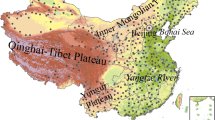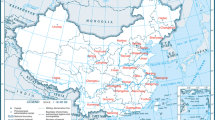Abstract
In this paper, the thermal comfort and its changes in the Qinghai–Tibet Plateau over the last 50 years have been evaluated by using the physiological equivalent temperature (PET), and a more complete tourism climate picture is presented by the Climate–Tourism–Information Scheme (CTIS). The results show that PET classes in the Qinghai–Tibet Plateau cover six out of the nine-point thermal sensation scale — very cold, cold, cool, slightly cool, neutral and slightly warm — and cold stress is prevailing throughout the year. A small number of slightly cool/warm and neutral days occur in summer months. There occur no warm, hot and very hot days. The frequency of PET classes varies among regions, depending on their altitude/latitude conditions. Xining, Lhasa and Yushu are the top three cities in terms of thermal favorability. With global warming, annual cumulative number of thermally favorable days has been increasing, and that of cold stress has been reducing. The change is more obvious in lower elevation than that in higher elevation regions. The improving thermal comfort in the Qinghai–Tibet Plateau might be a glad tiding for local communities and tourists. Besides PET, CTIS can provide a number of additional bioclimatic information related to tourism and recreational activities. CTIS for Lhasa and Xining shows that sunshine is plentiful all the year round, and windy days occur frequently from late January to early May. This is a useful bioclimatic information for tourism authorities, travel agencies, resorts and tourists.









Similar content being viewed by others
References
Anderson GS (1999) Human morphology and temperature regulation. Int J Biometeorol 43(3):99–109. doi:10.1007/s004840050123
Çahşkan O, Çiçek İ, Matzarakis A (2012) The climate and bioclimate of Bursa (Turkey) from the perspective of tourism. Theor Appl Climatol 107:417–425. doi:10.1007/s 00704-011-0489-6
Chen L, Ng E (2012) Outdoor thermal comfort and outdoor activities: a review of research in the past decade. Cities 29(2):118–125. doi:10.1016/j.cities.2011.08.006
Chen L, Fang XQ, Li S (2007) The impact of climate warming on the southern boundary of Chinese freezing and cold regions and the heating energy consumption. Chin Sci Bull 52(10):1195–1198. doi:10.1007/s11434-007-0386-7 (in Chinese)
China Meteorological Administration (2013) The daily data set of ground climatic data in China. http://old-cdc.cma.gov.cn/shuju/index3.jsp?tpcat=SURF_CLI_CHN_MUL_DAY
de Freitas CR (2003) Tourism climatology: evaluating environmental information for decision making and business planning in the recreation and tourism sector. Int J Biometeorol 48(1):45–54. doi:10.1007/s00484-003-0177-z
Djongyang N, Tchinda R, Njomo D (2010) Thermal comfort: a review paper. Renew Sustain Energy Rev 14(9):2626–2640. doi:10.1016/j.rser.2010.07.040
Eludoyin OM, Adelekan IO (2013) The physiologic climate of Nigeria. Int J Biometeorol 57(2):241–264. doi:10.1007/s00484-012-0549-3
Endler C, Oehler K, Matzarakis A (2010) Vertical gradient of climate change and climate tourism conditions in the Black Forest. Int J Biometeorol 54(1):45–61. doi:10.1007/s00484-009-0251-2
Farajzadeh H, Matzarakis A (2012) Evaluation of thermal comfort conditions in Ourmieh Lake, Iran. Theor Appl Climatol 107:451–459. doi:10.1007/s00704-011-0492-y
Fuller S, Bulkeley H (2013) Changing countries, changing climates: achieving thermal comfort through adaptation in everyday activities. Area 45(1):63–69. doi:10.1111/j.1475-4762.2012.01105.x
Goh C (2012) Exploring impact of climate on tourism demand. Ann Tourism Res 39(4):1859–188. doi:10.1016/j.annals.2012.05.027
Hall R, Roy D, Boling D (2004) Pleistocene migration routes into the Americas: human biological adaptations and environmental constraints. Evolution Anthropol 13(4):132–144. doi:10.1002/evan.20013
Hamilton JM, Lau MA (2005) The role of climate information in tourist destination choice decision-making. In: Proceedings of the 17th International Congress of Biometeorology (ICB 2005), Garmisch-Partenkirchen, Germany, 9–5 September 2005. Deutscher Wetterdienst, Offenbach am Main, pp 608–611
Holmes MJ, Hacker JN (2007) Climate change, thermal comfort and energy: meeting the design challenges of the 21st century. Energ, Buildings 39(7):802–814. doi:10.1016/j.enbuild.2007.02.009
Höppe PR (1993) Heat balance modeling. Experientia 49(9):741–746
Höppe PR (1999) The physiological equivalent temperature – a universal index for the biometeorological assessment of the thermal environment. Int J Biometeorol 43:71–75. doi:10.1007/s004840050118
IPCC (2007) Climate change 2007: The physical science basis: contribution of Working Group I to the fourth assessment report of the Intergovernmental Panel on Climate Change. Cambridge University Press, Cambridge
Kaiser K, Lai ZP, Schneider B, Reudenbach C, Miehe G, Brückner H (2009) Stratigraphy and palaeoenvironmental implications of Pleistocene and Holocene Aeolian sediments in the Lhasa area, southern Tibet (China). Palaeogeogr Palaeoclimatol Palaeoecol 271(3–4):329–342. doi:10.1016/j.palaeo.2008.11.004
Kendrick, RJ (2005) An introduction using SPSS. Pearson Education Canada, Newmarket Canada
Knez I, Thorsson S (2006) Influences of culture and environmental attitude on thermal, emotional and perceptual evaluations of a public square. Int J Biometeorol 50:258–268. doi:10.1007/s00484-006-0024-0
Kozak M (2002) Comparative analysis of tourist motivations by nationality and destinations. Tourism Manage 23(3):221–232. doi:10.1016/S0261-5177(01)00090-5
Li CL, Kang SC (2006) Review of the studies on climate change since the last inter-glacial period on the Tibetan Plateau. J Geogr Sci 16(3):337–345. doi:10.1007/s11442-006-0309-6
Lin TP, Matzarakis A (2008) Tourism climate and thermal comfort in Sun Moon Lake, Taiwan. Int J Biometeorol 52:281–290. doi:10.1007/s00484-007-0122-7
Lin TP, Matzarakis A (2011) Tourism climate information based on human thermal perception in Taiwan and Eastern China. Tourism Manage 32:492–500. doi:10.1016/j.tourman.2010.03.017
Lin TP, Hwang CC, Cheng HY (2006) The influence of climate information on travel arrangements. In: Proceedings of the 8th leisure, recreation and tourism research symposium, Taipei. Outdoor Recreation Association, Taipei, pp 120–126
Madsen DB, Ma H, Brantingham PJ, Gao X, Rhode D, Zhang H, Olsen JW (2006) The late Upper Paleolithic occupation of the northern Tibetan Plateau margin. J Archaeol Sci 33:1433–1444. doi:10.1016/j.jas.2006.01.017
Matzarakis A, Mayer H (1996) Another kind of environmental stress: thermal stress. WHO News 18:7–10
Matzarakis A, Mayer H (1997) Heat stress in Greece. Int J Biometeorol 41:34–39. doi:10.1007/s004840050051
Matzarakis A, Mayer H, Iziomon MG (1999) Applications of a universal thermal index: physiological equivalent temperature. Int J Biometeorol 43:76–84. doi:10.1007/s004840050119
Matzarakis A, de Freitas C, Scott D (2004) Advances in tourism climatology. Berichte des Meteorologischen Institutes der Universität, Freiburg
Matzarakis A, Rutz F, Mayer H (2007) Modeling radiation fluxes in simple and complex environments – application of the RayMan model. Int J Biometeorol 51:323–334. doi:10.1007/s00484-006-0061-8
Matzarakis A, Rutz F, Mayer H (2010) Modeling radiation fluxes in simple and complex environments: basics of the RayMan model. Int J Biometeorol 54:131–139. doi:10.1007/s00484-009-0261-0
Matzarakis A, Hammerle M, Koch E, Rudel E (2012) The climate tourism potential of Alpine destinations using the example of Sonnblick, Rauris and Salzburg. Theorl Appl Climatol 110:645–658. doi:10.1007/s00704-012-0686-y
Mayer H, Höppe PR (1987) Thermal comfort of man in different urban environments. Theor Appl Climatol 38(1):43–49. doi:10.1007/BF00866252
Mayhew B, Bellezza J, Wheeler T, Taylor C (1999) Lonely Planet Tibet, 4th edn. Lonely Planet Publications, Melbourne
McGregor GR (2012) Human biometeorology. Prog Physl Geogr 36(1):93–109. doi:10.1177/0309133311417942
Mousavi ME, Irish JL, Frey AE, Olivera F, Edge BL (2011) Global warming and hurricanes: the potential impact of hurricane intensification and sea level rise on coastal flooding. Clim Chang 104(3–4):575–597. doi:10.1007/s10584-009-9790-0
Oliver JE (2011) Climate and man’s environment: an introduction to applied climatology. John Wiley, New York
Rhode D, Zhang HY, Madsen DB, Gao X, Brantingham PJ, Ma HZ, Olsen JW (2007) Epipaleolithic/early Neolithic settlements at Qinghai Lake, western China. J Archaeol Sci 34(4):600–612. doi:10.1016/j.jas.2006.06.016
Solymosi N, Torma C, Kern A et al (2010) Changing climate in Hungary and trends in the annual number of heat stress days. Int J Biometeorol 54(4):423–431. doi:10.1007/s00484-009-0293-5
Statistics Bureau of Qinghai Province (2001–2011), Qinghai statistical yearbook. China Statistics Press, Beijing, China (in Chinese)
Statistics Bureau of Tibet Autonomous Region (2001–2011) Tibet statistical yearbook. China Statistics Press, Beijing, China (in Chinese)
Taffé P (1997) A qualitative response model of thermal comfort. Build Env 32:115–121. doi:10.1016/S0360-1323(96)00035-2
Terjung WH (1966) Physiologic climates of the conterminous United States: a bioclimatic classification based on man. Ann Assoc Am Geogr 56(1):141–179
Thorsson S, Lindberg F, Bj¨orklund J, Holmer B, Rayner D (2011) Potential changes in outdoor thermal comfort conditions in Gothenburg, Sweden due to climate change: the influence of urban geometry. Int J Climatol 31:324–335. doi:10.1002/joc.2231
Tromp SW (1963) Medical biometeorology. Elsevier, Amsterdam
Wong SL, Wan KKW, Yang L, Lam JC (2012) Changes in bioclimates in different climates around the world and implications for the built environment. Build Environ 57:214–222. doi:10.1016/j.buildenv.2012.05.006
Yasuhara K, Murakami S, Mimura N (2007) Influence of global warming on coastal infrastructural instability. Sustain Sci 2(1):13–25. doi:10.1007/s11625-006-0015-4
Zaninović K, Matzarakis A (2009) The biometeorological leaflet as a means conveying climatological information to tourists and the tourism industry. Int J Biometeorol 53:369–374. doi:10.1007/s00484-009-0219-2
Zaninović K, Matzarakis A, Cegnar T (2006) Thermal comfort trends and variability in the Croatian and Slovenian mountains. Meteorol Z 15(2):243–251. doi:10.1127/0941-2948/2006/0119
Zheng ZF (2011) Characteristics of climate warming and human body comfort index in Beijing during last 50 years. Adv Mater Res 183–185:1105–1109. doi:10.4028/www.scientific.net/AMR.183-185.1105
Acknowledgments
We thank two anonymous referees for their suggestive revision comments on the earlier versions of the manuscript. We are grateful to Prof. Matzarakis for his generous provision of the RayMan program, and to Mr. Dune for his careful proofreading of the paper. This work is supported by the National Natural Science Foundation of China (Project No. 30571524).
Author information
Authors and Affiliations
Corresponding author
Rights and permissions
About this article
Cite this article
Li, R., Chi, X. Thermal comfort and tourism climate changes in the Qinghai–Tibet Plateau in the last 50 years. Theor Appl Climatol 117, 613–624 (2014). https://doi.org/10.1007/s00704-013-1027-5
Received:
Accepted:
Published:
Issue Date:
DOI: https://doi.org/10.1007/s00704-013-1027-5




